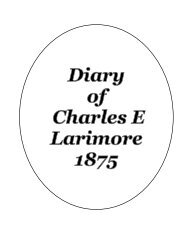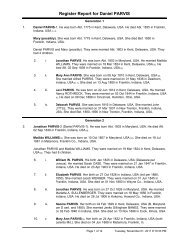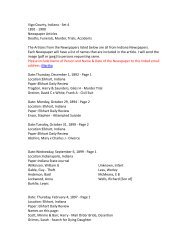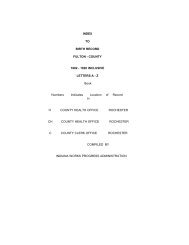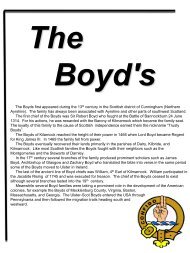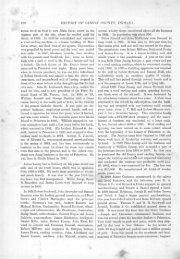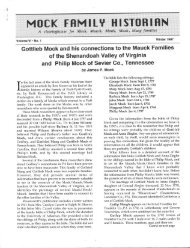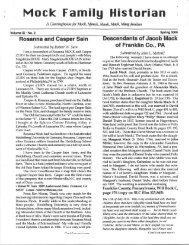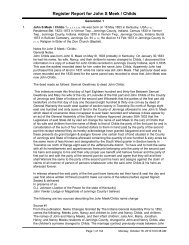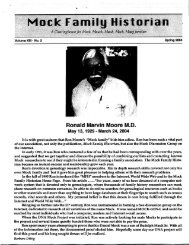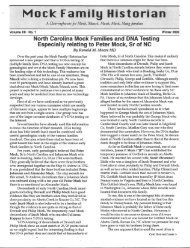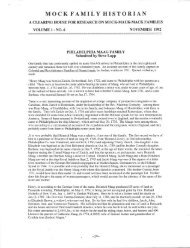A Genealogy Report For WILLIAM M BASSETT - INGenWeb
A Genealogy Report For WILLIAM M BASSETT - INGenWeb
A Genealogy Report For WILLIAM M BASSETT - INGenWeb
Create successful ePaper yourself
Turn your PDF publications into a flip-book with our unique Google optimized e-Paper software.
William M Bassett Direct Relations<br />
- Mary E., wife, age 72, {1848} born Indiana, father born IN, mother born Ohio.<br />
Living on Buckeye St, Bloomfield, Davis,Iowa. Roll: T625_485 Page: 18A ED: 1 Image: 0884 Roll T625-485, page 18A.<br />
{Note: TJ Walker family lived at Locust & Buckeye.}<br />
1930 US Census<br />
William M Bassett, Gender: Male, Age: 78 Marital Status: Married, Race: White, Birthplace: Indiana, Estimated Birth<br />
Year: 1852 Immigration Year: , Relationship to Head of Household: Head Father's Birthplace: Indiana Mother's Birthplace:<br />
Ohio. Military Service: NO. Owns home value:$2000, Age at first marriage: 22. Parents' birthplace: IN/OH. Owned a<br />
radio: NO, can read & write.<br />
- Jennie Bassett, Gender: Female, Age: 75, Marital Status: Married, Race: White, Birthplace: Iowa, Estimated Birth Year:<br />
1855, Immigration Year: ,Relationship to Head of Household: Wife, Father's Birthplace: Tennessee, Mother's Birthplace:<br />
Tennessee. First maried at 22.<br />
Event: CENSUS Event Date: 1930 Event Place: Bloomfield, Davis, Iowa. 408 South buckeye, Bloomfield, Davis, Iowa; Roll:<br />
T626_651; Page: 10B; Enumeration District: 20; Image: 0647. Taken 16 April 1930. [Question as to where the middle<br />
initial M came from?]<br />
Enumeration District Number: 20 Family Number: 323 Sheet Number and Letter: 10B Line Number: 90 NARA Publication:<br />
T626, roll 651 Film Number: 2340386 Digital Folder Number: 4584395 Image Number: 00650.<br />
BIOGRAPHY:<br />
1. Family lived for 4 years [ca 1875-1879] in Mercer County MO, moved to Davis County IA in 1879,<br />
and to Bloomfield, Davis County, in 1903. They were farmers.<br />
2. Note from Blanche Battin/JOHNSON, about 1988: "They (William & Priscilla <strong>BASSETT</strong>) farmed (I think in Davis<br />
County). Lived 4 years in Mercer Co., came to Davis Co. 1879 and to Bloomfield 1903. Priscilla had asthma, which Ora<br />
inherited, as did Lolla, altho she did not have [line ends...] After Priscilla died Wm married again three times. The first<br />
marriage did not work out and he lost considerable money during it. The second marriage was to a comfortable<br />
grandmotherly woman I knew as "grandmother". The last time was to have someone to take care of him. I remember him as<br />
a nice fellow with white hair who had a big vegetable & strawberry garden."<br />
3. Member of the Wesley Chapel M.E. Church, along with Lewis BOWLING, Nathen PUFFER,; Lewis, Uriah, Amos, Josiah,<br />
and Mell ROIMNGER; William M. MILLSAP, A.K. DUCKWORTH.<br />
http://iagenweb.org/davis/Newsletter/Vol_XX_No_4.pdf<br />
http://www.rootsweb.ancestry.com/~iabiog/davis/d1882/d1882-b.htm#Bassett,%20W.%20M.<br />
History of Davis County, Iowa.<br />
Bassett, W. M., farmer, section 9, postoffice Bloomfield; was born in Ripley county, Ind., March 29, 1851. When he was three<br />
years old his father, William, came to Lyon county, Iowa, where he grew to manhood on a farm and was educated in the<br />
common schools and Cornell College. In 1874, he went to Mercer county, Mo., and in 1878, settled on his present farm in<br />
this county, where he owns 145 acres of well improved land, a comfortable house surrounded with evergreens, a large barn<br />
and orchard of eight acres, with a great variety of small fruits. He was married April 15, 1873, to Miss Princilla H. Puffer of<br />
Linn county, daughter of Chas. Puffer, Esqr. They have two children: Ora B. and Frank L. In politics Mr. B. is a<br />
greenbacker. He is a genial man and highly thought of. [Note: Wrtiten prior to 1884 birth of son - Austin Edwin Bassett]<br />
BIOGRAPHY:<br />
HISTORY: Linn County, Iowa From the A.T. Andreas Illustrated Historical Atlas of the State of Iowa, 1875 *Copyright. All<br />
rights reserved.LINN COUNTY The surface of the country in Linn County is undulating, and, like Jones County, is broken<br />
into low, conical hills, with intersecting valleys running in every direction, while the general inclination is to the southeast<br />
and south, the water-shed being near the south bank of the Wapisinicon River, and extending nearly parallel with it. The soil<br />
is good, the whole county well watered, and the climate conducive to health. Well water is peculiarly pure and sparkling. The<br />
people are cheerful, busy and properous. [sic] All professions are well sustained, and industry is well rewarded. EARLY<br />
SETTLEMENT The first cabin within the limits of Linn County was built by John Mann, in Linn Grove, on what is known as<br />
Upper Big Creek, in February, 1838. It is said (though disputed by some) that he was the first white settler.<br />
RESOURCES There is but very little waste land in Linn County. The soil is exceedingly fertile being of a rich, dark sandy<br />
loam, and of great depth. Corn, oats, wheat and potatoes are good crops – some of them superior, - while no country is<br />
better for grazing. Tobacco, sweet potatoes, grapes and sorghum are cultivated to a considerable extent. Fruits are good,<br />
especially the small fruits and berries. Apple trees do not do so well, but we believe the difficulty is not in the soil, nor in the<br />
climate, but in making a wrong selection of the kind of fruit trees, and with not raising them from the seed without<br />
transplanting, and then grafting upon the undisturbed stalk. Linn County annually exports a large quantity of wheat, corn,<br />
flaxseed, oats, barley, pork, wool, hides, beef, etc. The timber is more abundant than in most prairie counties, and it is of a<br />
superior quality. Nearly one-third of the county is covered with beautiful groves of hickory, oak, walnut, sugar maple, linn,<br />
elm, ash and other kinds of salable timber for manufacturing purposes and for fuel. Clay exists in various parts sufficient to<br />
Page 6



